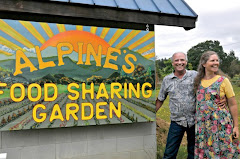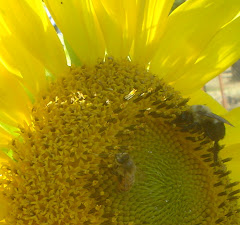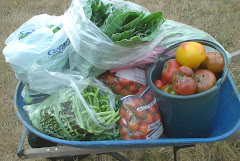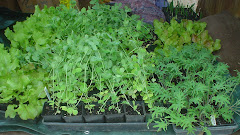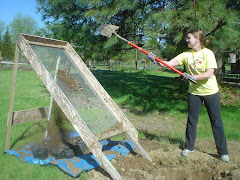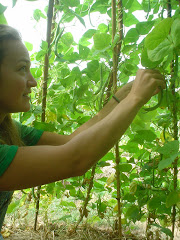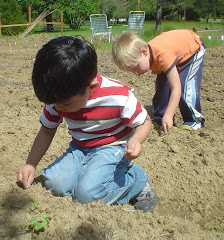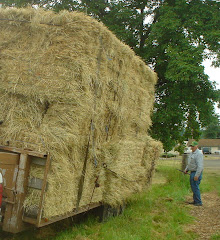 |
| Did you know that the average-sized deciduous tree can provide fertilizer for your garden worth about $50.00? This article outlines a few ways to utilize this mineral-rich resource, primarily through composting. |
Greetings friends, here in our part of the world,
we're headed into winter; the Gardens have (mostly) been put to sleep
and we have time to reflect on this past season and share with you in a
deeper way. Here's a post about our new "budding" relationship with our
local Grade School, and their help in gathering leaves for the Sharing
Gardens.
Early
in autumn, we were approached by the science teacher for 12-13 year-old
students at the school that shares our back fence-line - Monroe Grade
School. Marie-Louise has a classroom window that looks out on our
gardens and had been curious for many years about a way to partner with
the Sharing Gardens on a mutually-beneficial project. Her class was
doing a unit on "Sustainability" and needed to find a way to perform
"community service" (volunteering) that was related to living a
sustainable lifestyle.
 |
| It's challenging enough to keep a small group of college-age students focused and busy so we needed a project appropriate to a large group of 12-13 year-olds! |
We knew, from our experience coordinating "community
service" projects with Oregon State University that it can be a
challenge to focus the attention of even a small group of
college-age
students for an extended period of time so we had some concerns about
bringing much larger groups of 7th-graders to help us directly in the
gardens. After brainstorming for a few minutes, Chris had a great idea
when he suggested we coordinate a leaf-raking project in our small town
of
Monroe, Oregon.
 |
| Llyn and Chris presenting info about mulching and compost. |
In order to provide a
context for the leaf-raking, Chris and I visited Marie-Louise's
classroom
with some samples of leaves and grass-clippings in various stages of
decay to show the students how the leaves turn into soil-fertilizer. We
explained that, at the Sharing Gardens, we no longer
buy fertilizer from stores but
create soil-fertility primarily
by feeding the worms and micro-organisms in our soil. (We also use
wood-ash from heating our house). The fertile soil then grows the
nutrient-packed vegetables that we share in the community with those in
need. (If you want to know more about how the Sharing Gardens work,
click this
LINK.)
 |
| We brought compost in various stages of decay... |
A week later, the two classes of 16-18 students each,
took a short, walking 'field-trip' to the Sharing Gardens. We toured
the grounds in two
smaller groups so they could continue to make
the connection between raking leaves, and growing food, and living more
sustainably. We were happy to see some of the young people show a real
interest in what we do and how we live. One girl asked, "What's it like
to be a vegetarian?". Another asked sincerely, "How do you cook
anything
without a microwave oven?". One young man found a moth that had landed
on a plant and wondered if it would be alright if he picked it up.
"Sure," I said, "as long as you're gentle. The insects are our friends
in the garden." I watched him gingerly pick up the moth and shepherd it
around for the rest of the tour, placing it gently on another plant as
he left.
 |
| Garden tour: "Wow, compost!" |
 |
| Garden tour: Everybody loves shelling beans! |
We decided to make the leaf-raking itself -
truly voluntary - so we wouldn't have a lot
of students dragging their feet and resenting being
required to do it. We set aside two Saturday mornings (and later picked
one)
in hopes of having good weather, and to assure that enough leaves would
have fallen to make it worth everyone's time. Chris and I rode our
bikes around town the afternoon before the Leaf-Raking Day in order to
map out the route to rake the most leaves. Marie-Louise had her students
make a few posters which they hung on community bulletin-boards so
people would know we were coming. We also made fliers to distribute on
the day of the raking that explained the project and told people how to
donate
more leaves, if they were interested.
 |
| It's easier to fill bags if you work as a team. |
 |
| We picked a day after the leaves had really begun to fall in quantity. |
We
had a beautiful day to do the raking with crisp, sunny weather. We had
eight or nine students come help with the raking along with four
parents. We raked for about two hours and collected 37
giant bags of leaves. One of the parents had also done some raking with her two children at home and brought another nine bags!
 |
| Someone had heard we were coming and piled up all her leaves so all we had to do was bag them. |
It
takes a lot of leaves to mulch our entire garden, the orchards and
greenhouses! So far, we've never had too many leaves but this year, we
just might get close!
 |
| Leaf-raking isn't all work; here's one girl jumping in the raked pile. |
Special thanks go to:
First Alternative Food Co-op - $30 gift certificate to buy organic apple juice and popcorn for snacks
Monroe's United Methodist Church (our neighbor) - who provided bathrooms for the rakers to use before and after the project
The
parents who chaperoned
The
students who helped with the raking and
especially to Marie-Louise
for reaching out to us and for doing all the extra work of getting
permission-slips signed, buying the snacks and all the other steps that
made this a successful project. We look forward to continued
collaborations in the future!
Feel free to pass this post along to the
teachers in your life. Raking leaves can be a fun and meaningful way for
students to be of service in your community. We'd be glad to share our
experience and provide templates for permission-slips and fliers.












